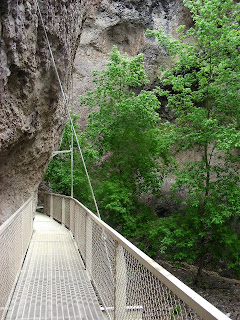 Gila River at TNC's Gila River Preserve (View upstream toward Gila Wilderness)
Gila River at TNC's Gila River Preserve (View upstream toward Gila Wilderness)  Gila Wilderness as viewed upstream from the Gila River at TNC's Gila River Farm Preserve
Gila Wilderness as viewed upstream from the Gila River at TNC's Gila River Farm Preserve- Mallard (Anas platyrhynchos)
- Turkey Vulture (Cathartes aura)
- Common Black-Hawk (Buteogallus anthracinus)--rare, pair on a nest
- Red-tailed Hawk (Buteo jamaicensis)
- American Kestrel (Falco sparverius)
- Mourning Dove (Zenaida macroura)
- Eurasian Collared-Dove (Streptopelia decaocto) *
- Killdeer (Charadrius vociferus)
- Great Horned Owl (Bubo virginianus)
- Northern (Red-shafted) Flicker (Colaptes auratus)
- Ladder-backed Woodpecker (Picoides scalaris) *
- Western Wood-Pewee (Contopus sordidulus)
- Cordilleran Flycatcher (Empidonax occidentalis) *
- Black Phoebe (Sayornis nigricans)
- Say's Phoebe (Sayornis saya)
- Ash-throated Flycatcher (Myiarchus cinerascens)
- Western Kingbird (Tyrannus verticalis)
- Cassin's Kingbird (Tyrannus vociferans)
- Vermilion Flycatcher (Pyrocephalus rubinus)
- Common Raven (Corvus corax)
- Chihuahuan Raven (Corvus cryptoleucus) *
- Northern Rough-winged Swallow (Stelgidopteryx serripennis)
- Violet-green Swallow (Tachycineta thalassina)
- Barn Swallow (Hirundo rustica)
- Bewick's Wren (Thryomanes bewickii)
- European Starling (Sturnus vulgaris)
- Lucy's Warbler (Vermivora luciae) *
- Yellow-breasted Chat (Icteria virens)
- Common Yellowthroat (Geothlypis trichas)
- Summer Tanager (Piranga rubra)
- Northern Cardinal (Cardinalis cardinalis)
- Blue Grosbeak (Guiraca caerulea) *
- Western Meadowlark (Sturnella neglecta)
- Red-winged Blackbird (Agelaius phoeniceus)
- Great-tailed Grackle (Quiscalus mexicanus)
- Brown-headed Cowbird (Molothrus ater)
- Bullock's Oriole (Icterus bullockii)
One thing that truck me when we finished our walk was how much of the avifauna of the grasslands and shrublands of New Mexico is comprised of flycatchers. Of the 37 species we observed that morning, nearly a quarter (eight) were flycatchers. Gila River flowing southwest from TNC's Gila River Farm Preserve
Gila River flowing southwest from TNC's Gila River Farm PreserveAs we were driving out of the preserve after our walk, headed for the Catwalk National Recreation Trail, we came across a huge King Snake stretched across the road. The rest of the group, which was following in cars behind us, stopped to see the snake, and then gently encouraged it to move off the road.
 Taking Woodstock is a pleasant diversion but not one of Ang Lee's better films. There are two principal problems. First, the main character, Elliot Teichberg, is so bland that it's hard to develop much interest in him. Second, his mother is so patently unpleasant from beginning to end that you can't muster any sympathy for her plight. (Near the end of the film, Elliot asks his father why his father has stayed with his mother for 40 years. His father replies, "Because I love her." This woman is so unlovable that you don't buy it for a second.) Furthermore, any film in which the second-tier characters are the most interesting (e.g., Liev Shreiber as the transvestite ex-Marine Vilma and Eugene Levy as dairy farmer Max Yasgur) is in trouble from the get go.
Taking Woodstock is a pleasant diversion but not one of Ang Lee's better films. There are two principal problems. First, the main character, Elliot Teichberg, is so bland that it's hard to develop much interest in him. Second, his mother is so patently unpleasant from beginning to end that you can't muster any sympathy for her plight. (Near the end of the film, Elliot asks his father why his father has stayed with his mother for 40 years. His father replies, "Because I love her." This woman is so unlovable that you don't buy it for a second.) Furthermore, any film in which the second-tier characters are the most interesting (e.g., Liev Shreiber as the transvestite ex-Marine Vilma and Eugene Levy as dairy farmer Max Yasgur) is in trouble from the get go.










































